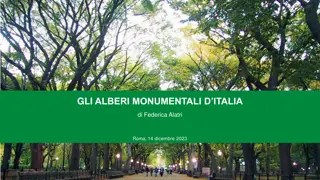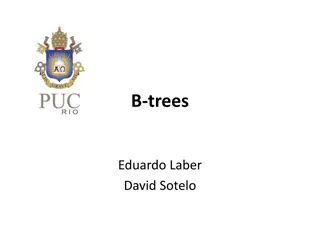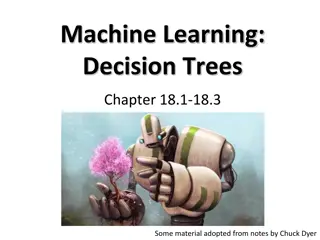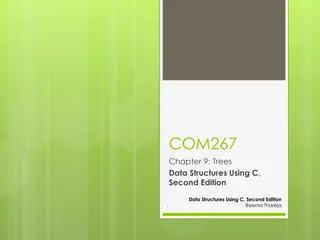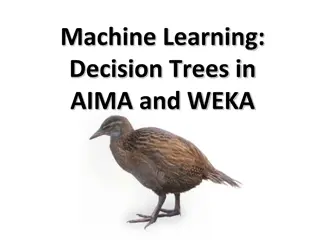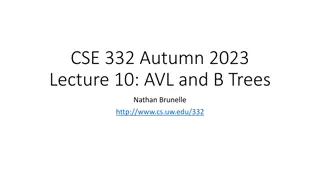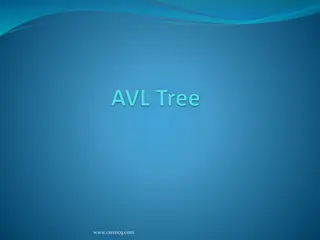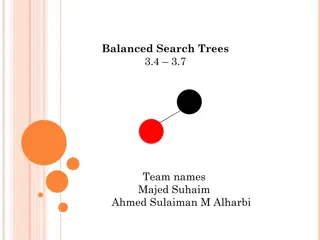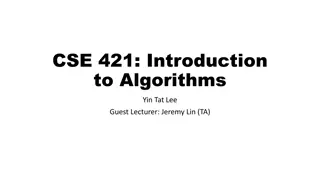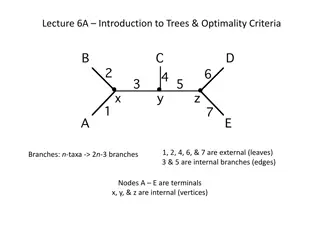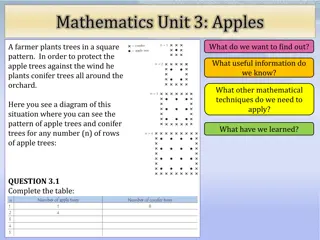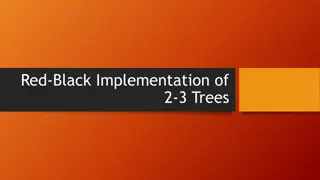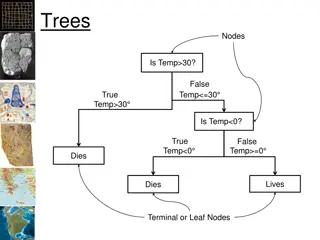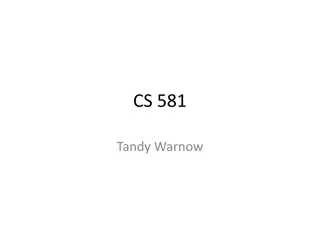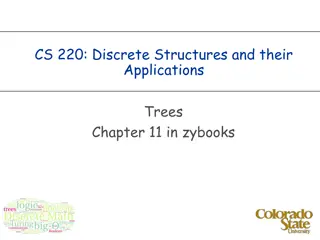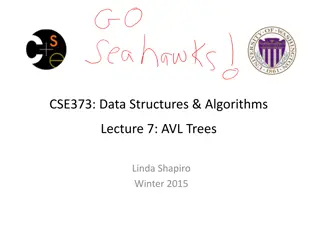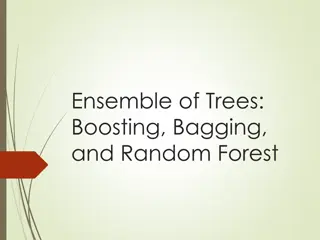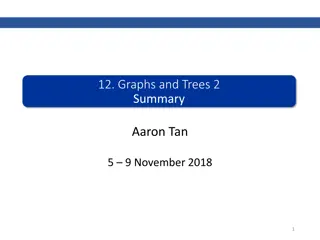Introduction to Trees and Their Applications in Various Fields
A detailed overview of trees in computer science, chemistry, geology, botany, psychology, and more, exploring their applications as models. Learn about the definition of trees, spanning trees, tree traversal, structural induction proofs, and the role of trees in representing organizational structures and computer file systems.
Download Presentation

Please find below an Image/Link to download the presentation.
The content on the website is provided AS IS for your information and personal use only. It may not be sold, licensed, or shared on other websites without obtaining consent from the author.If you encounter any issues during the download, it is possible that the publisher has removed the file from their server.
You are allowed to download the files provided on this website for personal or commercial use, subject to the condition that they are used lawfully. All files are the property of their respective owners.
The content on the website is provided AS IS for your information and personal use only. It may not be sold, licensed, or shared on other websites without obtaining consent from the author.
E N D
Presentation Transcript
Chapter Summary Introduction to Trees Applications of Trees (not currently included in overheads) Tree Traversal Recursive Definitions of Rooted Trees Structural Induction Proofs of Tree Properties Spanning Trees Minimum Spanning Trees (not currently included in overheads) 2
Trees Definition: A tree is a connected undirected graph with no simple circuits. Example: Which of these graphs are trees? Solution: G1 and G2 are trees - both are connected and have no simple circuits. Because e, b, a, d, e is a simple circuit, G3 is not a tree. G4 is not a tree because it is not connected. Definition: A forest is a graph that has no simple circuit, but is not connected. Each of the connected components in a forest is a tree. 3
Trees (continued) Theorem: An undirected graph is a tree if and only if there is a unique simple path between any two of its vertices. Proof: Assume that T is a tree. Then T is connected with no simple circuits. Hence, if x and y are distinct vertices of T, there is a simple path between them (by Theorem 1 of Section 10.4). This path must be unique - for if there were a second path, there would be a simple circuit in T (by Exercise 59 of Section 10.4). Hence, there is a unique simple path between any two vertices of a tree. Now assume that there is a unique simple path between any two vertices of a graph T. Then T is connected because there is a path between any two of its vertices. Furthermore, T can have no simple circuits since if there were a simple circuit, there would be two paths between some two vertices. Hence, a graph with a unique simple path between any two vertices is a tree. 4
Arthur Cayley (1821-1895) Trees as Models Trees are used as models in computer science, chemistry, geology, botany, psychology, and many other areas. Trees were introduced by the mathematician Cayley in 1857 in his work counting the number of isomers of saturated hydrocarbons. The two isomers of butane are shown at the right. The organization of a computer file system into directories, subdirectories, and files is naturally represented as a tree. Trees are used to represent the structure of organizations. 5
Arthur Cayley (1821-1895) Trees as Models Trees are used as models in computer science, chemistry, geology, botany, psychology, and many other areas. Trees were introduced by the mathematician Cayley in 1857 in his work counting the number of isomers of saturated hydrocarbons. The two isomers of butane are shown at the right. The organization of a computer file system into directories, subdirectories, and files is naturally represented as a tree. Trees are used to represent the structure of organizations. 6
Programs as Trees Program Abstract Syntax Tree (AST) The process of generating an AST from a program is called PARSING And it is usually the first stage conducted by a COMPILER 7
Rooted Trees Definition: A rooted tree is a tree in which one vertex has been designated as the root and every edge is directed away from the root. An unrooted tree is converted into different rooted trees when different vertices are chosen as the root. 8
Rooted Tree Terminology Terminology for rooted trees is a mix from botany and genealogy (such as this family tree of the Bernoulli family of mathematicians). If v is a vertex of a rooted tree other than the root, the parent of v is the unique vertex u such that there is a directed edge from u to v. When u is a parent of v, v is called a child of u. Vertices with the same parent are called siblings. The ancestors of a vertex are the vertices in the path from the root to this vertex, excluding the vertex itself and including the root. The descendantsof a vertex v are those vertices that have v as an ancestor. A vertex of a rooted tree with no children is called a leaf. Vertices that have children are called internal vertices. If a is a vertex in a tree, the subtreewith a as its root is the subgraph of the tree consisting of a and its descendants and all edges incident to these descendants. 9
Terminology for Rooted Trees Example: In the rooted tree T (with root a): (i) Find the parent of c, the children of g, the siblings of h, the ancestors of e, and the descendants of b. (ii) Find all internal vertices and all leaves. (iii) What is the subtree rooted at G? Solution: (i) The parent of c is b. The children of g are h, i, and j. The siblings of h are i and j. The ancestors of e are c, b, and a. The descendants of b are c, d, and e. The internal vertices are a, b, c, g, h, and j. The leaves are d, e, f, i, k, l, and m. We display the subtree rooted at g. (ii) (iii) 10
Tree Traversal Procedures for systematically visiting every vertex of an ordered tree are called traversals. The three most commonly used traversals are preordertraversal, inorder traversal, and postorder traversal. 11
Preorder Traversal Definition: Let T be an ordered rooted tree with root r. If T consists only of r, then r is the preorder traversal of T. Otherwise, suppose that T1, T2, , Tn are the subtrees of r from left to right in T. The preorder traversal begins by visiting r, and continues by traversing T1 in preorder, then T2 in preorder, and so on, until Tn is traversed in preorder. 12
Preorder Traversal (continued) procedure preorder (T: ordered rooted tree) r := root of T list r for each child c of r from left to right T(c) := subtree with c as root preorder(T(c)) 13
Inorder Traversal Definition: Let T be an ordered rooted tree with root r. If T consists only of r, then r is the inorder traversal of T. Otherwise, suppose that T1, T2, , Tn are the subtrees of r from left to right in T. The inorder traversal begins by traversing T1 in inorder, then visiting r, and continues by traversing T2 in inorder, and so on, until Tn is traversed in inorder. 14
Inorder Traversal (continued) procedure inorder (T: ordered rooted tree) r := root of T ifr is a leaf then list r else l:= first child of r from left to right T(l) := subtree with l as its root inorder(T(l)) list(r) for each child c of r from left to right T(c) := subtree with c as root inorder(T(c)) 15
Postorder Traversal Definition: Let T be an ordered rooted tree with root r. If T consists only of r, then r is the postorder traversal of T. Otherwise, suppose that T1, T2, , Tn are the subtrees of r from left to right in T. The postorder traversal begins by traversing T1 in postorder, then T2 in postorder, and so on, after Tn is traversed in postorder, r is visited. 16
Postorder Traversal (continued) procedure postordered (T: ordered rooted tree) r := root of T for each child c of r from left to right T(c) := subtree with c as root postorder(T(c)) list r 17
Expression Trees Complex expressions can be represented using ordered rooted trees. Consider the expression ((x + y) 2 ) + ((x 4)/3). A binary tree for the expression can be built from the bottom up, as is illustrated here. 18
Infix Notation An inorder traversal of the tree representing an expression produces the original expression when parentheses are included except for unary operations, which now immediately follow their operands. We illustrate why parentheses are needed with an example that displays three trees all yield the same infix representation. x + y / x + 3 19
Jan ukasiewicz (1878-1956) Prefix Notation Example: We show the steps used to evaluate a particular prefix expression: When we traverse the rooted tree representation of an expression in preorder, we obtain the prefix form of the expression. Expressions in prefix form are said to be in Polish notation,named after the Polish logician Jan ukasiewicz. Operators precede their operands in the prefix form of an expression. Parentheses are not needed as the representation is unambiguous. The prefix form of ((x + y) 2 ) + ((x 4)/3) is + + x y 2 / x 4 3. Prefix expressions are evaluated by working from right to left. When we encounter an operator, we perform the corresponding operation with the two operations to the right. 20
Example: We show the steps used to evaluate a particular postfix expression. Postfix Notation We obtain the postfix form of an expression by traversing its binary trees in postorder. Expressions written in postfix form are said to be in reverse Polish notation. Parentheses are not needed as the postfix form is unambiguous. x y + 2 x 4 3 /+ is the postfix form of ((x + y) 2 ) + ((x 4)/3). A binary operator follows its two operands. So, to evaluate an expression one works from left to right, carrying out an operation represented by an operator on its preceding operands. 21
The Bound for the Number of Leaves in an m-Ary Tree Theorem 5 5: There are at most mh leaves in an m-ary tree of height h. Proof(by mathematical induction on height): BASIS STEP: Consider an m-ary trees of height 1. The tree consists of a root and no more than m children, all leaves. Hence, there are no more than m1 = m leaves in an m-ary tree of height 1. INDUCTIVE STEP: Assume the result is true for all m-ary trees of height < h. Let T be an m-ary tree of height h. The leaves of T are the leaves of the subtrees of T we get when we delete the edges from the root to each of the vertices of level 1. Each of these subtrees has height h 1. By the inductive hypothesis, each of these subtrees has at most mh 1 leaves. Since there are at most m such subtees, there are at most m mh 1 = mh leaves in the tree. Corollary 1 1: If an m-ary tree of height h has l leaves, then h logm l . If the m-ary tree is full and balanced, then h = logm l . (see text for the proof) 22
Rooted Trees Definition: The set of rooted trees, where a rooted tree consists of a set of vertices containing a distinguished vertex called the root, and edges connecting these vertices, can be defined recursively by these steps: BASIS STEP: :A single vertex r is a rooted tree. RECURSIVE STEP: Suppose that T1, T2, ,Tn are disjoint rooted trees with roots r1, r2, ,rn, respectively. Then the graph formed by starting with a root r, which is not in any of the rooted trees T1, T2, ,Tn, and adding an edge from r to each of the vertices r1, r2, ,rn, is also a rooted tree. 23
Building Up Rooted Trees Trees are studied extensively in Chapter 11. Next we look at a special type of tree, the full binary tree. 24
Full Binary Trees Definition: The set of full binary trees can be defined recursively by these steps. BASIS STEP: There is a full binary tree consisting of only a single vertex r. RECURSIVE STEP: If T1 and T2 are disjoint full binary trees, there is a full binary tree, denoted by T1 T2, consisting of a root r together with edges connecting the root to each of the roots of the left subtree T1 and the right subtree T2. 25
Structural Induction General Approach Definition: To prove a property of the elements of a recursively defined set, we use structural induction. BASIS STEP: Show that the result holds for all elements specified in the basis step of the recursive definition. RECURSIVE STEP: Show that if the statement is true for each of the elements used to construct new elements in the recursive step of the definition, the result holds for these new elements. The validity of structural induction can be shown to follow from the principle of mathematical induction. 27
Properties of Full Binary Trees Definition: The heighth(T) of a full binary tree T is defined recursively as follows: BASIS STEP: The height of a full binary tree T consisting of only a root r is h(T) = 0. RECURSIVE STEP: If T1 and T2are full binary trees, then the full binary tree T = T1 T2has height h(T) = 1 + max(h(T1),h(T2)). Definition: The number of vertices n(T) of a full binary tree T satisfies the following recursive formula: BASIS STEP: The number of vertices of a full binary tree T consisting of only a root r is n(T) = 1. RECURSIVE STEP: If T1 and T2are full binary trees, then the full binary tree T = T1 T2has the number of vertices n(T) = 1 + n(T1) + n(T2). 28
Structural Induction and Binary Trees Theorem: If T is a full binary tree, then n(T) 2h(T)+1 1. Proof: Use structural induction. BASIS STEP: The result holds for a full binary tree consisting only of a root, n(T) = 1 and h(T) = 0. Hence, n(T) = 1 20+1 1 = 1. RECURSIVE STEP: Assume n(T1) 2h(T1)+1 1 and also n(T2) 2h(T2)+1 1 whenever T1 and T2are full binary trees. n(T) = 1 + n(T1) + n(T2) (by recursive formula of n(T)) 1 + (2h(T1)+1 1) + (2h(T2)+1 1) (by inductive hypothesis) 2 max(2h(T1)+1 ,2h(T2)+1 ) 1 = 2 2max(h(T1),h(T2))+1 1 = 2 2h(t) 1 (by recursive definition of h(T)) = 2h(t)+1 1 ( a + b 2 max(a,b) ) (max(2x , 2y)= 2max(x,y) ) 2 . 29
m-ary Rooted Trees Definition: A rooted tree is called an m-ary tree if every internal vertex has no more than m children. The tree is called a full m-ary tree if every internal vertex has exactly m children. An m-ary tree with m = 2 is called a binary tree. Example: Are the following rooted trees full m-ary trees for some positive integer m? Solution: T1 is a full binary tree because each of its internal vertices has two children. T2is a full 3-ary tree because each of its internal vertices has three children. In T3 each internal vertex has five children, so T3 is a full 5-ary tree. T4is not a full m-ary tree for any m because some of its internal vertices have two children and others have three children. 30
Ordered Rooted Trees Definition: An ordered rooted tree is a rooted tree where the children of each internal vertex are ordered. We draw ordered rooted trees so that the children of each internal vertex are shown in order from left to right. Definition: A binary tree is an ordered rooted where each internal vertex has at most two children. If an internal vertex of a binary tree has two children, the first is called the left child and the second the right child. The tree rooted at the left child of a vertex is called the left subtree of this vertex, and the tree rooted at the right child of a vertex is called the right subtree of this vertex. Example: Consider the binary tree T. (i) What are the left and right children of d? (ii) What are the left and right subtrees of c? Solution: (i) The left child of d is f and the right child is g. (ii) The left and right subtrees of c are displayed in (b) and (c). 31
Properties of Trees Theorem 2 2: A tree with n vertices has n 1 edges. Proof(by mathematical induction): BASIS STEP: When n = 1, a tree with one vertex has no edges. Hence, the theorem holds when n = 1. INDUCTIVE STEP: Assume that every tree with k vertices has k 1 edges. Suppose that a tree T has k + 1 vertices and that v is a leaf of T. Let w be the parent of v. Removing the vertex v and the edge connecting w to v produces a tree T with k vertices. By the inductive hypothesis, T has k 1 edges. Because T has one more edge than T , we see that T has k edges. This completes the inductive step. 32
Counting Vertices in Full m-Ary Trees Theorem 3 3: A full m-ary tree with i internal vertices has n = mi + 1 vertices. Proof : Every vertex, except the root, is the child of an internal vertex. Because each of the i internal vertices has m children, there are mi vertices in the tree that are children of another node (i.e. other than the root). Hence, the tree contains n = mi + 1 vertices. 33
Counting Vertices in Full m-Ary Trees (continued) Theorem 4 4: A full m-ary tree with (i) n vertices has i = (n 1)/m internal vertices and l = [(m 1)n + 1]/m leaves, i internal vertices has n = mi + 1 vertices and l= (m 1)i + 1 leaves, (ii) proofs of parts (ii) and (iii) are left as exercises (iii) l leaves has n = (ml 1)/(m 1) vertices and i = (l 1)/ (m 1) internal vertices. Proof(of part i): Solving for i in n = mi + 1 (from Theorem 3) gives i = (n 1)/m. Since each vertex is either a leaf or an internal vertex, n = l + i. By solving for l and using the formula for i, we see that l = n i = n (n 1)/m = [(m 1)n + 1]/m . 34
Level of vertices and height of trees When working with trees, we often want to have rooted trees where the subtrees at each vertex contain paths of approximately the same length. To make this idea precise we need some definitions: The level of a vertex v in a rooted tree is the length of the unique path from the root to this vertex. The height of a rooted tree is the maximum of the levels of the vertices. Example: (i) Find the level of each vertex in the tree to the right. (ii) What is the height of the tree? Solution: (i) The root a is at level 0. Vertices b, j, and k are at level 1. Vertices c, e, f, and l are at level 2. Vertices d, g, i, m, and n are at level 3. Vertex h is at level 4. (ii) The height is 4, since 4 is the largest level of any vertex. 35
Balanced m-Ary Trees Definition: A rooted m-ary tree of height h is balanced if all leaves are at levels h or h 1. Example: Which of the rooted trees shown below is balanced? Solution: T1and T3 are balanced, but T2 is not because it has leaves at levels 2, 3, and 4. 36


